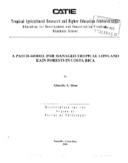| dc.contributor.author | Sitoe, Almeida A. | |
| dc.date.accessioned | 2020-11-20T21:50:15Z | |
| dc.date.available | 2020-11-20T21:50:15Z | |
| dc.date.issued | 2000 | |
| dc.identifier.uri | https://repositorio.catie.ac.cr/handle/11554/10005 | |
| dc.description | Tesis (Ph. D.)--CATIE, Turrialba (Costa Rica), 2000 | es_ES |
| dc.description | Referencias en las páginas 146-157 | |
| dc.description | Ilustraciones. Tablas | |
| dc.description | 157 páginas | |
| dc.description.abstract | The gap modelig approach was used to develop a simulation model for Pentaclethra forests of the Central American Atlantic Moist ecoregion. The model uses empirically estimated functions fitted from a eight-years field data. These functions include diameter growth, height function, and the effects of crown exposure and form on diameter increment. Volume functions were obtained from local literature. Ecologically estimated parameters were obtained for those procedures not directly fitted from field data. Trial and error procedure was used to calibrate the desired model output level. The model was tested and evaluated comparing long-term simulations with the presently known characteristics of Pentaclethra forest. Ecologically estimated parameters were evaluated for sensitivity. The resulting model called Gavilán, after the Spanish name of Pentaclethra macroloba, the most abundant species, could represent most of the dynamic charateristics of Pentaclethra forest. The use of species growth rate and position of the adult size on the mature forest strata for diameter increment functions produced a modeling efficiency of 0.39. These species groups were also used to estimate growth mortality and recruitment parameters to give a more realistic approach. Initial species abundance and gap opening are used together with species regeneration guild to estimate the probability of a species to establish. The model maintained the characteristics of Pentaclethra forest over a simulation period of 400 years, starting from an observed plot after logging. Ecological parameters were moderately sensitive, and a variation of 20 percent of the initial value produced between 6 and 25 percent in the model output. The model was used to estimate the cutting cycles when the silvicultural treatment of liberation was applied. This was found to be between 15 and 35 years with a sustainable yield of about 20 m3 ha-1 in each harvesting. After 200 years of successively logging in a 20 years periodicity the forest structure, the species richness and diversity were maintained. These findings suggest that forest management of Pentaclethra forests could be done in an ecologically sustainable way if logging intensity and silvicultural treatments are maintained within reasonable limits. | es_ES |
| dc.language.iso | en | es_ES |
| dc.publisher | CATIE, Turriaba (Costa Rica) | es_ES |
| dc.subject | BOSQUE TROPICAL HUMEDO | |
| dc.subject | PENTACLETHRA MACROLOBA | |
| dc.subject | SISTEMA DE RENUEVOS DE CEPA | |
| dc.subject | MANEJO FORESTAL | |
| dc.subject | MODELOS DE SIMULACION | |
| dc.subject | MODELOS DINAMICOS | |
| dc.subject | PRODUCCION FORESTAL | |
| dc.subject | BIOMASA | |
| dc.subject | COSTA RICA | |
| dc.subject | TROPICAL RAIN FORESTS | |
| dc.subject | COPPICE SYSTEM | |
| dc.subject | SIMULATION MODELS | |
| dc.subject | DYNAMIC MODELS | |
| dc.subject | FORESTRY PRODUCTION | |
| dc.subject | BIOMASS | |
| dc.title | A patch-model for managed tropical lowland rain forests in Costa Rica | es_ES |
| dc.type | Tesis | es_ES |


